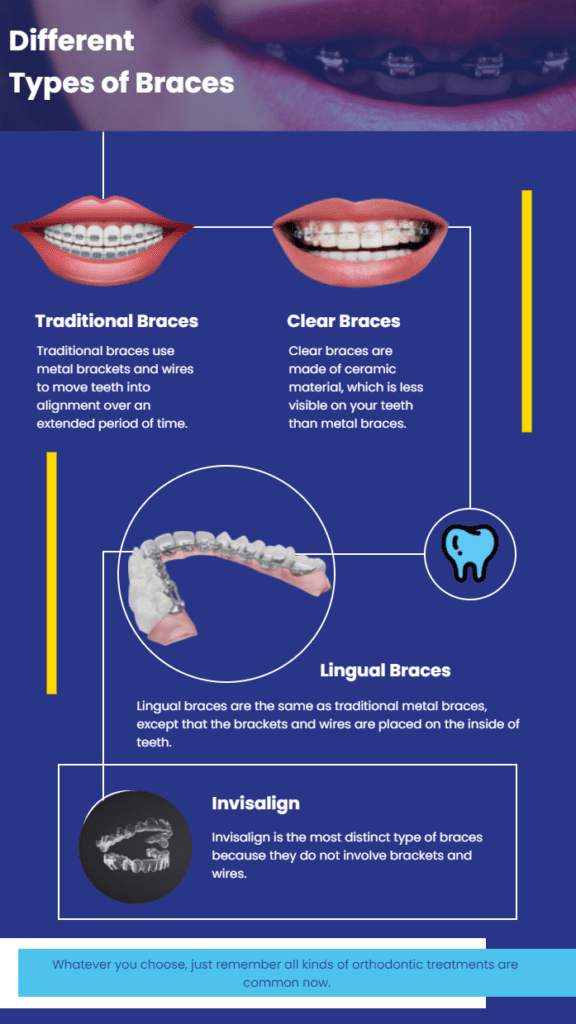What Establishes Cumming Braces and Aligners Aside From Other Orthodontic Treatments
What Establishes Cumming Braces and Aligners Aside From Other Orthodontic Treatments
Blog Article
Comprehensive Overview to Orthodontics Procedures for Correcting Dental Misalignments
Recognizing the complexities of each treatment, including their systems, benefits, and prospective downsides, is vital in making informed choices regarding one's orthodontic treatment. As we browse with the thorough guide to orthodontic treatments for dealing with oral misalignments, the complex details of each approach will unfold, dropping light on the path towards a harmonious and useful dental positioning.
Orthodontic Procedures Summary

Regular adjustments and tracking are critical parts of orthodontic treatment to make sure development is on track and to make any kind of essential adjustments along the method. By undertaking orthodontic procedures, people can not only accomplish a straighter smile but also improve their general dental health and function.
Typical Dental Braces: Just How They Function
When considering orthodontic therapies for dental imbalances, traditional dental braces stand apart as a tried and true method for dealing with teeth placing. Conventional dental braces contain brackets, wires, and bands that interact to apply constant pressure on the teeth, gradually moving them into the desired placement. The brackets are connected to the teeth utilizing an unique adhesive, and the cords are threaded through the braces. By changing the tension of the wires, orthodontists can control the direction and force related to each tooth, assisting them into correct alignment over time.
One secret element of just how standard dental braces work is the process of bone makeover. As stress is related to the teeth through the braces, the bone bordering the teeth is improved to support the brand-new tooth placements. This makeover is important for the lasting security of the dealt with alignment. Clients will certainly need normal adjustments at the orthodontist's workplace to ensure the dental braces remain to use the appropriate pressure for efficient teeth movement.
Invisible Aligners: Cons and pros
Undetectable aligners use a discreet and practical choice to traditional dental braces for correcting oral misalignments. These clear, tailor-made trays are basically undetectable when put on, making them an appealing option for people looking for a much more aesthetically pleasing orthodontic treatment. Among the main advantages of unnoticeable aligners is their removability, permitting easier upkeep of dental health compared to standard dental braces. People can get rid of the aligners prior to consuming or brushing their teeth, reducing the risk of food obtaining stuck in the device and simplifying the cleaning procedure.

Surgical Orthodontic Options
Surgical interventions in orthodontics existing practical options for resolving complex dental misalignments that may not be effectively solved with conventional orthodontic treatments. While unseen aligners and conventional braces can remedy many orthodontic issues, certain instances call for surgical intervention to achieve optimal outcomes. Surgical orthodontic options are generally suggested for severe malocclusions, considerable jaw inconsistencies, and cases where the underlying bone framework needs modification to achieve appropriate alignment.
One common surgical orthodontic treatment is orthognathic surgery, which entails repositioning the jaws to deal with functional issues such as trouble chewing or speaking. This surgical procedure is commonly performed in partnership with an orthodontist who assists line up the teeth prior to and after the procedure. Surgical orthodontics may additionally involve treatments to subject impacted teeth, remove excess gum cells, or reshape the jawbone to develop an extra harmonious facial profile.
Before taking into consideration surgical orthodontic options, clients go through a thorough analysis to determine the requirement and possible advantages of such treatments. orthodontics. While surgical treatment might appear challenging, it can considerably boost both the feature and visual appeals of the smile in situations where conventional orthodontic therapies fail
Retainers and Post-Treatment Care

Post-treatment treatment involves following the orthodontist's guidelines carefully. This may include correct dental hygiene practices, going to follow-up visits, and wearing the weblink retainers as prescribed. Failing to follow post-treatment care directions can cause regression, where the teeth progressively return towards their original placements. Consistent retainer wear, excellent dental health, and routine oral examinations are necessary for preserving the outcomes accomplished via orthodontic surgery and guaranteeing the lasting security of the corrected dental positioning.
Final Thought
In conclusion, orthodontic treatments offer various options for remedying oral misalignments. Surgical orthodontic choices are available for a lot more extreme imbalances. Generally, orthodontic procedures can successfully enhance dental health and wellness and aesthetic look.
As we browse with the comprehensive overview to orthodontic treatments for correcting dental imbalances, the elaborate details of each method will certainly unfold, losing light on the path toward a unified and functional oral placement. - cumming orthodontics
One of the most typical orthodontic treatments is the use of dental braces, which consist of metal braces and cords that apply gentle pressure to progressively shift teeth into the desired position.When taking into consideration orthodontic treatments for dental misalignments, typical dental braces stand out as a time-tested approach for remedying teeth placing. Furthermore, unseen aligners might not be suitable for intricate orthodontic issues that require more substantial teeth motion, as they are generally suggested for light to moderate cases. Retainers are custom-made orthodontic tools made click here for info to hold teeth in their fixed settings after the completion of orthodontic therapy.
Report this page